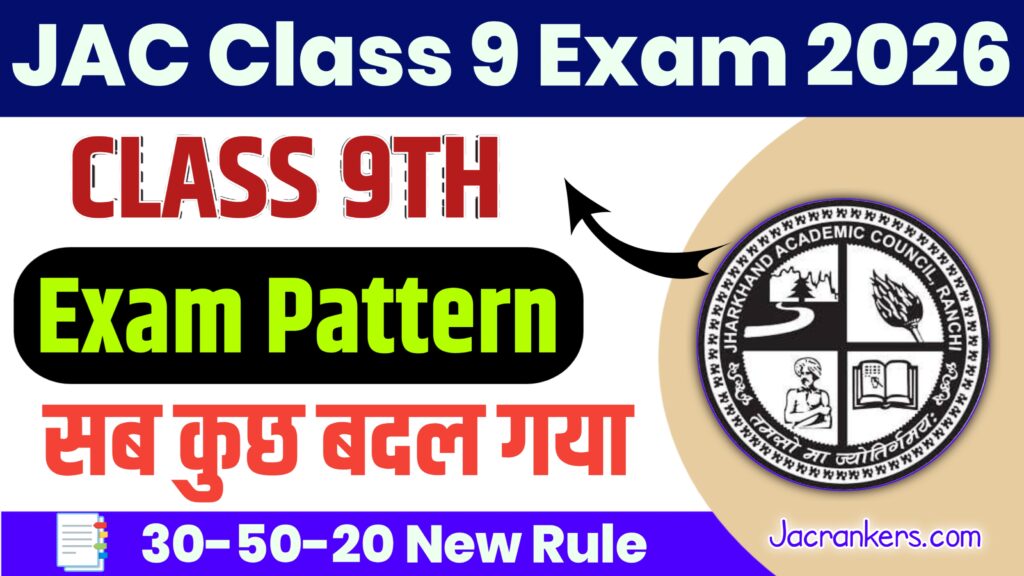Last Updated on 7, November 2025 by JAC Rankers
JAC Class 9 Exam Pattern 2026
Welcome to our comprehensive guide on the Jharkhand Academic Council (JAC) Class 9 Exam Pattern for 2026. If you’re a student preparing for this crucial year, understanding the exam structure is essential. The JAC has introduced a revamped pattern with a “30-50-20” assessment formula, emphasizing objective questions, subjective evaluations, and school internal assessments. In this post, we’ll break it down step by step, including details on weightage, passing criteria, and tips to succeed.

JAC Class 9 Exam Pattern 2026
| Aspect | Details |
|---|---|
| Assessment Formula | 30% Objective (MCQs), 50% Subjective (Short/Long Answers), 20% School Internal Assessments |
| Subjects | Mathematics, Science, Social Science, Hindi, English |
| Passing Criteria | 33% in each subject, pass 4/5 subjects for promotion |
| Grace Marks | Available for failure in one subject |
| Exam Duration | 3 hours per subject |
Introduction to JAC Class 9 Exam Pattern 2026
The JAC Class 9 exams for 2026 are set to undergo significant changes. The new “30-50-20” formula divides the assessment into 30% objective questions (Multiple Choice Questions or MCQs), 50% subjective questions (short and long answers), and 20% school internal assessments (like projects, assignments, and practicals). This shift aims to test students’ conceptual understanding, analytical skills, and overall performance more holistically. Students will be evaluated across five main subjects: Mathematics, Science, Social Science, Hindi, and English. The exams are typically held in March-April, with results announced in May-June.
यह नया पैटर्न छात्रों को अधिक व्यापक रूप से तैयार करने में मदद करेगा, क्योंकि यह सिर्फ रटने पर निर्भर नहीं है।
Detailed Assessment Formula
The core of the exam pattern lies in its assessment formula. Here’s a breakdown:
- Objective Section (30%): This part consists of MCQs, where students choose the correct answer from multiple options. It’s designed to assess quick recall and basic understanding.
- Subjective Section (50%): This includes short-answer questions (e.g., 2-3 marks) and long-answer questions (e.g., 5-10 marks). It tests in-depth knowledge, problem-solving, and writing skills.
- School Internal Assessment (20%): This covers projects, assignments, practicals, and class participation, evaluated by teachers throughout the year.
The total marks per subject are usually 100, with the weightage applied accordingly. For example, in a 100-mark paper, 30 marks come from MCQs, 50 from subjective questions, and 20 from internal assessments.
30% Objective
50% Subjective
20% Internal
Total: 100%
Passing Criteria and Promotion Rules
To pass the Class 9 exams and move to Class 10, students must meet strict criteria. Here’s what you need to know:
- Minimum Score per Subject: 33% in each of the five subjects.
- Overall Promotion: Pass at least 4 out of 5 subjects.
- Grace Marks: If a student fails in one subject, grace marks may be awarded to help them pass, depending on JAC’s discretion.
Passing Criteria Summary
| Criteria | Details | Implication |
|---|---|---|
| Minimum Score per Subject | 33% | Fail if below in any subject |
| Overall Promotion | Pass 4/5 subjects | Can be promoted even if one subject is failed (with grace marks) |
| Grace Marks | For one subject failure | Helps borderline students |
Subjects Covered in JAC Class 9 Exams
The exams cover five core subjects, each with the 30-50-20 formula applied. Here’s a quick overview:
- Mathematics: Focuses on algebra, geometry, and statistics. Subjective questions may include proofs and problem-solving. Internal assessments could involve math projects.
- Science: Covers physics, chemistry, and biology. Expect diagrams and experiments in subjective parts, with practicals in internals.
- Social Science: Includes history, geography, and civics. Long answers might involve essays on historical events, plus map work in assessments.
- Hindi: Tests grammar, literature, and comprehension. Subjective section includes writing poems or stories, with creative assignments internally.
- English: Emphasizes reading, writing, and grammar. MCQs on vocabulary, subjective on essays, and presentations in internals.
Students should prepare a balanced study plan covering all subjects to meet the promotion criteria.
Preparation Tips for JAC Class 9 2026
With the new pattern, preparation needs to be strategic. Here are some tips:
- Practice MCQs: Use sample papers to get familiar with objective questions. Aim for speed and accuracy.
- Focus on Subjective Writing: Practice writing answers clearly. For long answers, structure them with introductions, body, and conclusions.
- Engage in Internal Assessments: Participate actively in projects and assignments to secure those 20% marks.
- Time Management: Allocate time based on weightage – spend more on subjective sections during practice.
- Revision: Regularly revise formulas, concepts, and key topics. Group study can help with subjective questions.
- Mock Tests: Take full-length tests to simulate exam conditions, including internal components.
छात्रों को नियमित अध्ययन और अभ्यास पर ध्यान देना चाहिए।
FAQs on JAC Class 9 Exam Pattern 2026
Here are some frequently asked questions to clear your doubts:
- What is the total duration of the exam?
- Each subject exam is typically 3 hours long, excluding internal assessments.
- Are there any changes in syllabus?
- The syllabus remains similar, but the pattern emphasizes application over rote learning, with added focus on internals.
- How are marks calculated?
- 30% from MCQs, 50% from subjective, and 20% from school internal assessments.
- What if I fail in two subjects?
- You may need to repeat Class 9, as per JAC rules.
- Where can I find sample papers?
- Check the official JAC website or educational portals for resources.
Conclusion
The JAC Class 9 Exam Pattern 2026 with its 30-50-20 formula is designed to build a strong foundation for higher classes. By understanding the weightage, passing criteria, and preparing effectively, students can excel. Remember, consistency.





